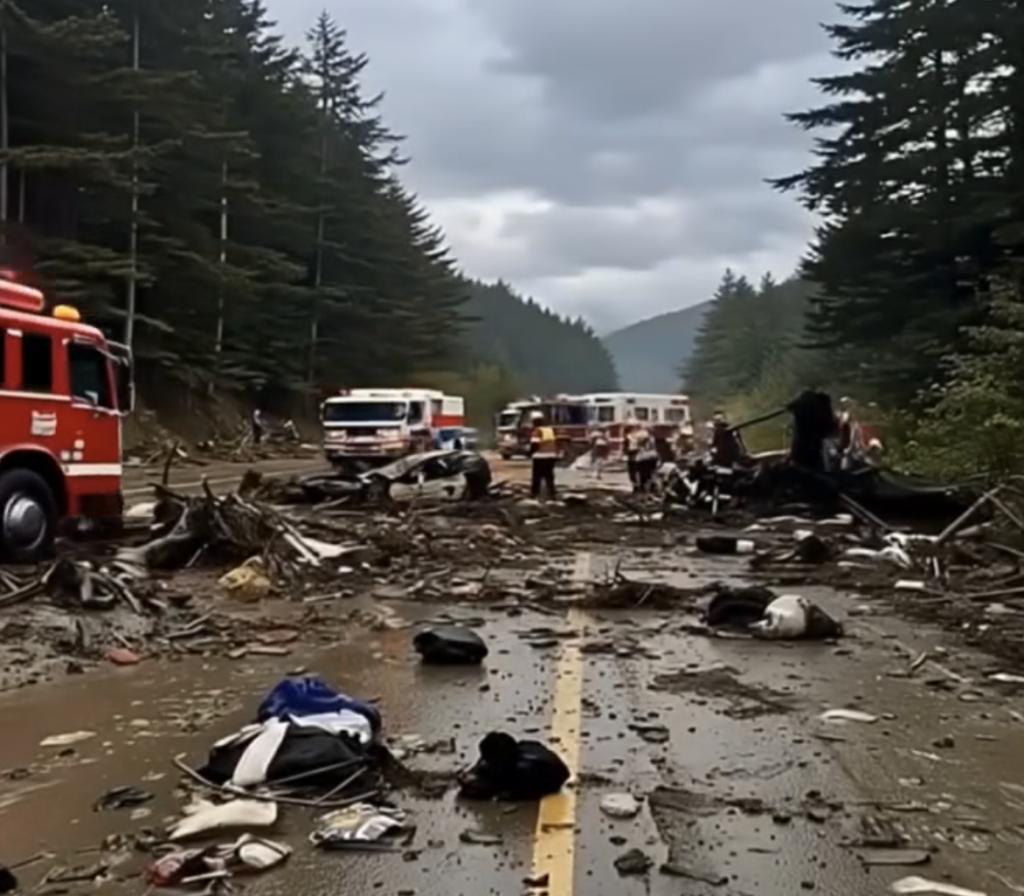🧨 Incident Summary
A sudden and catastrophic debris flow or landslide—likely triggered by heavy rainfall or flash flooding—swept through a forested mountainous highway, driving mud, water, rocks, trees, and debris across the roadway. Vehicles were caught in the flow, resulting in severe damage. First‑responders have mobilized in force, coordinating rescue, medical aid, and scene stabilization.
🔍 Scene Breakdown
-
Forested mountain highway: Tall evergreens and wet road surface indicate a slope above and a forested area below, typical of hilly terrain.
-
Extensive debris: Logs, mud, metal fragments, luggage and other personal items scattered across both lanes—consistent with a landslide or flood-related debris flow impacting passing vehicles.
-
Severely damaged vehicles: Cars crushed or torn apart, indicating strong impact force from fast-moving debris.
-
Emergency response: Multiple fire trucks, rescue personnel in high‑visibility vests and helmets, ambulances in the background—all pointing to a major rescue and recovery operation underway.
🩹 Likely Sequence of Events
-
Heavy rainstorm or rapid snowmelt saturated the slope above the highway, destabilizing soil and rocks.
-
Slope failure occurred, sending a fast-moving debris flow downhill across the road.
-
Vehicles traveling at the time were struck, some pushed or crushed by debris, others forced to stop amidst the chaos.
-
Emergency services were dispatched immediately, shutting the road, tending to victims, and initiating search, rescue, and debris clear‑up.
📰 Comparisons to Real Disasters
-
In Himachal Pradesh, India, relentless monsoon downpours triggered multiple landslides that damaged roads and vehicles, killed and injured residents, and hampered connectivity across hilly terrain The Times of IndiaThe Times of India.
-
A similarly tragic bus landslide in Nepal (Madan Ashrit Highway disaster) saw two passenger buses swept into a river by a monsoon-triggered slide, causing dozens of fatalities and disappearances Wikipedia.
-
In Ecuador (Baños landslide), heavy rain caused mudflows that struck cars, buses, and homes, leading to multiple deaths, injuries, and missing persons Wikipedia.
The scene in your image strongly resembles the aftermath of a flash flood–triggered landslide, given the volume of debris, smashed vehicles, and coordinated emergency response.
🧭 What Happens Next?
-
Search & rescue efforts will continue—teams may be looking for survivors or recovering victims among the wreckage.
-
The road will remain closed until geotechnical engineers deem the slope stable and cleanup operations complete.
-
Traffic disruptions could last hours or even days, especially if heavy equipment is needed to clear large debris or complete slope stabilization.
-
Authorities may issue travel warnings or emergency advisories for the region until conditions improve.
📌 Key Takeaways
| Element | Significance |
|---|---|
| Mud & log debris | Suggests debris flow rather than vehicle collision |
| Multiple destroyed cars | Indicates high-speed, forceful event |
| Emergency vehicles on site | Immediate and coordinated response |
| Forested, hilly terrain | Typical for landslides from storm triggers |
Would you like to dig deeper into possible safety protocols, landslide-triggering weather conditions, or explore first-person rescue footage from past similar incidents? Let me know which angle interests you most.



